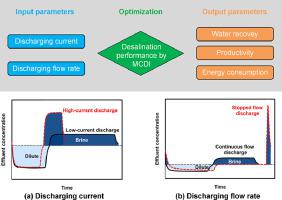Water Research ( IF 12.8 ) Pub Date : 2021-09-09 , DOI: 10.1016/j.watres.2021.117646 Zhizhao He 1 , Shuai Liu 2 , Boyue Lian 3 , John Fletcher 4 , Clare Bales 3 , Yuan Wang 1 , T David Waite 1

|
Membrane capacitive deionization (MCDI) is an emerging electric field-driven technology for brackish water desalination involving the removal of charged ions from saline source waters. While the desalination performance of MCDI under different operational modes has been widely investigated, most studies have concentrated on different charging conditions without considering discharging conditions. In this study, we investigate the effects of different discharging conditions on the desalination performance of MCDI electrode. Our study demonstrates that low-current discharge (1.0 mA/cm2) can increase salt removal by 20% and decrease volumetric energy consumption by 40% by improving electrode regeneration and increasing energy recovery, respectively, while high-current discharge (3.0 mA/cm2) can improve productivity by 70% at the expense of electrode regeneration and energy recovery. Whether discharging electrodes at the low current or high current is optimal depends on a trade-off between productivity and energy consumption. We also reveal that stopped flow discharge (85%) can achieve higher water recovery than continuous flow discharge (35–59%). However, stopped flow discharge caused a 20–30% decrease in concentration reduction and a 25–50% increase in molar energy consumption, possibly due to the higher ion concentration in the macropores at the end of discharging step. These results reveal that an optimal discharging operation should be obtained from achieving a balance among productivity, water recovery and energy consumption by varying discharging current and flow rate.
中文翻译:

使用可变放电操作优化膜电容去离子 (MCDI) 中的恒流操作
膜电容去离子 (MCDI) 是一种新兴的电场驱动技术,用于苦咸水淡化,涉及从咸水源水中去除带电离子。虽然 MCDI 在不同操作模式下的脱盐性能已得到广泛研究,但大多数研究都集中在不同的充电条件上,而没有考虑放电条件。在本研究中,我们研究了不同放电条件对 MCDI 电极脱盐性能的影响。我们的研究表明,低电流放电 (1.0 mA/cm 2 ) 可以分别通过改善电极再生和增加能量回收,将除盐率提高 20%,将体积能耗降低 40%,而大电流放电 (3.0 mA/ cm 2 )厘米2) 可以提高 70% 的生产率,但代价是电极再生和能量回收。以低电流或高电流放电电极是否最佳取决于生产率和能耗之间的权衡。我们还发现,停止流动排放(85%)比连续流动排放(35-59%)可以获得更高的水回收率。然而,停止流动放电导致浓度降低 20-30% 和摩尔能量消耗增加 25-50%,这可能是由于放电步骤结束时大孔中的离子浓度较高。这些结果表明,应通过改变排放电流和流量来实现生产率、水回收率和能耗之间的平衡,从而获得最佳排放操作。



























 京公网安备 11010802027423号
京公网安备 11010802027423号